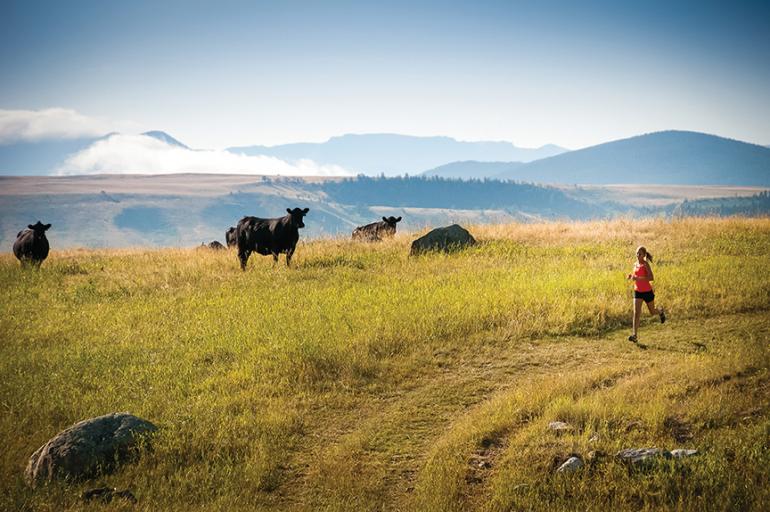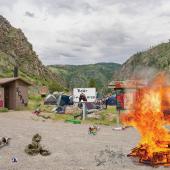Posted: Please Trespass
Reclaiming the right to roam.
America is often called the “Land of the Free,” yet we’re not free. Citizens aren’t confined, but rather restricted by an endless barrage of “No Trespassing” and “Keep Out” signs across the country. We think of this existence as normal, so normal that we rarely think about it at all. Yet, the proliferation of No Trespassing signs is a cultural aberration that is relatively recent, especially here in Montana, and very much at odds with traditions in other parts of the world.
Freedom to roam has been a custom, tradition, and presumed right since the days of the frontier, which persisted until recent times. I grew up with that tradition as a teenager in Bozeman in the 1980s. I walked nearby farm fields regularly, where I tracked everything from foxes to skunks in snow-covered fields. In a tangle of brush along an irrigation ditch, I built a hut of sticks and grass thatching, deepening my connection with nature. During weekends and summers, I went to my grandmother’s house in the country, where I walked for miles in every direction, crossing livestock fences all the way.
In 1988, at the age of 20, a friend and I walked five hundred miles across Montana, starting at my grandmother’s house in Pony and ending at Fort Union on the North Dakota border. We crossed private property for nearly half the adventure and rarely encountered landowners, but had largely positive encounters with those we met. A few were mildly disgruntled and suggested that we should be responsible and get a job, but waved us onward. Others invited us in for dinner.
The right to roam is a long-standing tradition in Scandinavian countries, known in Swedish as allemansrätten or “the everyman’s right.” These centuries-old traditions have been coded into law in recent decades. In Norway, Sweden, and Finland, people have the right to hike, ski, camp, and forage for wild food on undeveloped private properties, provided they respect landowners and don’t harm the environment. Similar customs and laws are found in Estonia, Latvia, Lithuania, Austria, Switzerland, Belarus, and the Czech Republic. Scotland also has a longstanding tradition of public access to private lands, which was formally recognized in law with Scotland’s Land Reform Act of 2003. England and Wales recently expanded public access with the Countryside and Rights of Way Act 2000, granting freedom to roam the open countryside.
Similarly, I toured New Zealand for five weeks this past winter, and never saw any No Trespassing or Keep Out signs. Most beaches and major watercourses are considered public property, as well as any little perennial or intermittent streams across private lands, with ample room to walk on either side. The country has an amazing system of trails across private lands, and it is culturally unacceptable to lock people out. One local told of a neighbor who migrated there from Pennsylvania and bought a large farm. The newcomers couldn’t legally close the public trail across their land, but they let the trail grow so thick with brush and tall grass that nobody wanted to go there anymore. The locals frowned at the inhospitality of these American transplants.
Unfortunately, “the everyman’s right” to roam has not yet been codified into law here in Montana, nor has it been written down as a guidebook for new residents. No Trespassing signs are a recent phenomenon, largely introduced by newcomers who, oblivious to Montana’s tradition of openness, imported their cultural expectations with them. Orange paint on a fence post signifies the same thing as a No Trespassing sign, so we have gained a few signs and a lot of orange paint, while losing access to millions of acres of land. Sadly, there wasn’t a public debate about it, because our cultural values were not recorded or publicized, and the loss occurred slowly, property by property across the state.
The cultural shift can be shocking to someone who experiences it for the first time. For example, one local rancher sold his property and retired. He was always pleased to see people out fishing the streams on his property, so he was alarmed and saddened to see that the new owners posted the property, and even he was not allowed to go back and walk the land he had called home for decades.
In Montana and across our nation, outdoor recreational opportunities are essential to wellbeing and quality of life. In lieu of a codified “everyman’s right,” we need to expand walking trails, water trails, and rail trails, and facilitate access to existing public lands. Just as importantly, we need to initiate a dialogue about the long-standing tradition of public access to private lands and bring awareness and desire to reclaim our essential heritage to freely roam the open countryside. We also need a statewide educational campaign to encourage landowners to paint their fence posts green to welcome healthy trespassing.
Thomas J. Elpel is the founder of Green University in Pony. He’s the author of numerous books, including Foraging the Mountain West and Participating in Nature. He also founded the Jefferson River Canoe Trail, spearheading group efforts to secure quality public campsites and to encourage conservation easements along the river corridor.













